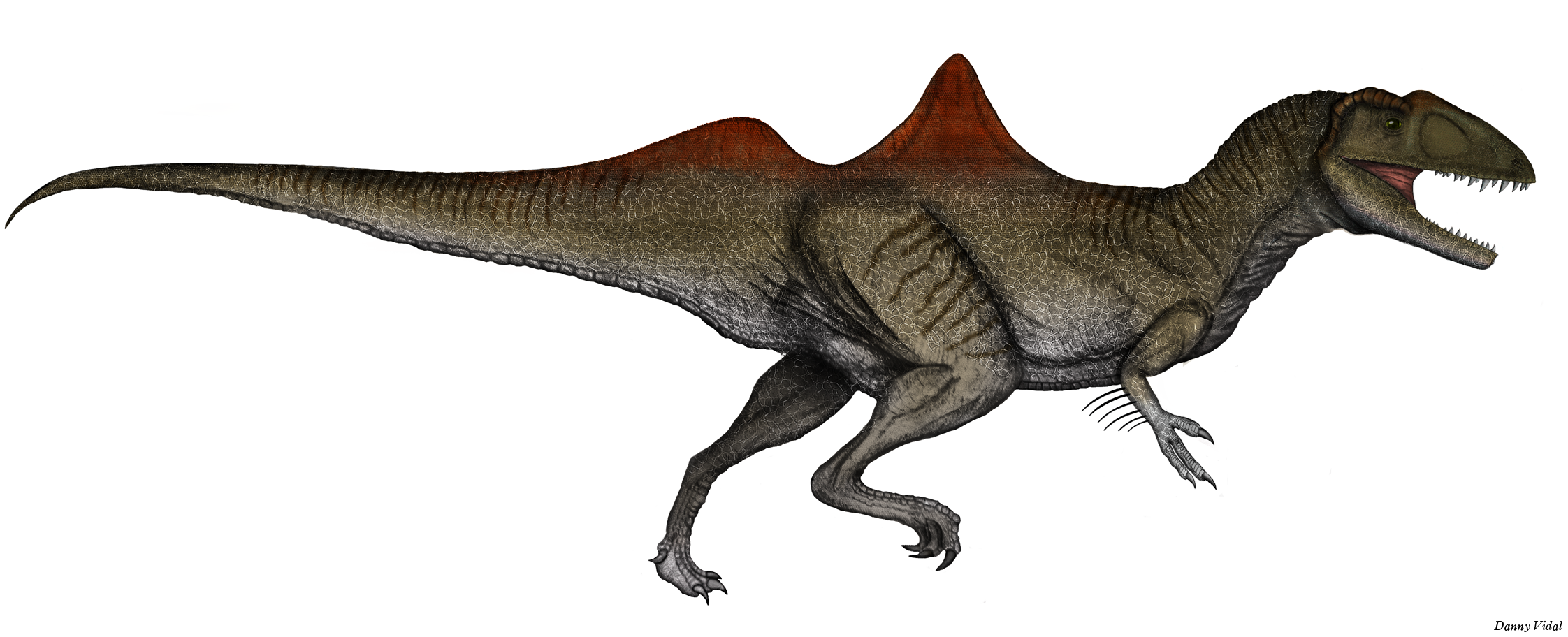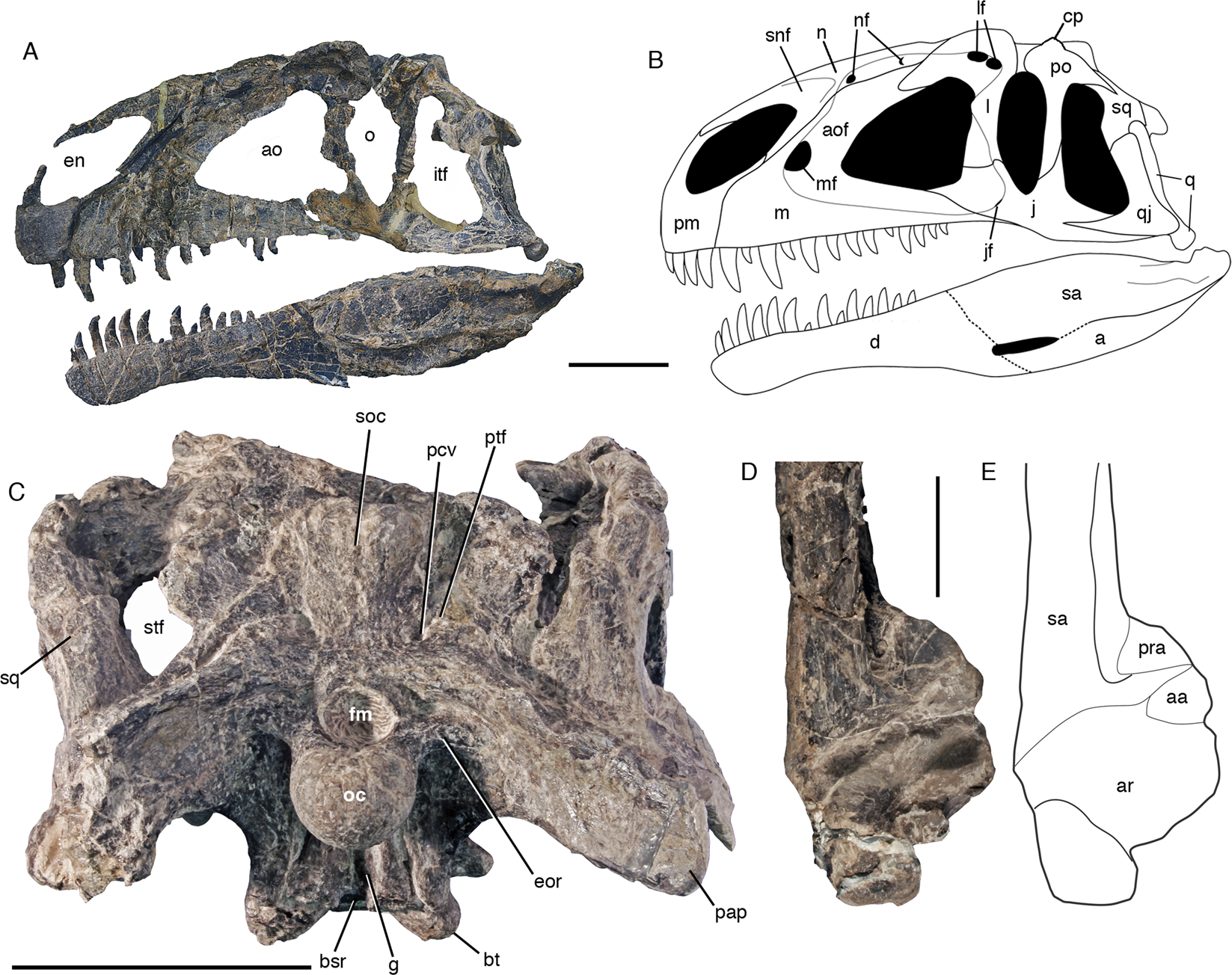|
Carcharodontosauria
Carnosauria is an extinct group of carnivorous theropod dinosaurs that lived during the Jurassic and Cretaceous periods. While Carnosauria was historically considered largely synonymous with Allosauroidea, some recent studies have revived Carnosauria as clade including both Allosauroidea and Megalosauroidea (which is sometimes recovered as paraphyletic with respect to Allosauroidea), and thus including the majority of non-coelurosaurian members of theropod clade Tetanurae. Other researchers have found Allosauroidea and Megalosauroidea to be unrelated groups.Cau A. (2024)A Unified Framework for Predatory Dinosaur Macroevolution Bollettino della Società Paleontologica Italiana, 63(1): 1-19. Distinctive characteristics of carnosaurs include large eye sockets, a long narrow skull and modifications of the legs and pelvis such as the thigh (femur) being longer than the shin (tibia). Carnosaurs first appeared in the Middle Jurassic around , and the last definitive carnosaur family ... [...More Info...] [...Related Items...] OR: [Wikipedia] [Google] [Baidu] |
Concavenator
''Concavenator'' (meaning Cuenca hunter) is a genus of carcharodontosaurian dinosaur that lived in Spain during the Early Cretaceous epoch, about 125 million years ago. The genus contains a single species, ''Concavenator corcovatus'', named and described in 2010 from a nearly complete skeleton collected from the Las Hoyas fossil site of the La Huérguina Formation. ''Concavenator'' was a medium-sized carcharodontosaurian, reaching about in length and in weight. Unlike most carcharodontosaurians, the neural spines of the last dorsal (back) vertebrae were tall, creating a sail-like structure. History The first fossil remains of ''Concavenator'' were recovered from limestone slabs of Las Hoyas locality (considered a '' Konservat-Lagerstätten''; deposits of exceptional fossil preservation) of Cuenca Province, Spain, which belongs to La Huérguina Formation. The remains were represented by an articulated, nearly complete skeleton of a theropod dinosaur individual encased in lim ... [...More Info...] [...Related Items...] OR: [Wikipedia] [Google] [Baidu] |
Lusovenator
''Lusovenator'' (meaning "Portuguese hunter") is a genus of carcharodontosaurian theropod dinosaur from the Late Jurassic (Kimmeridgian) Praia de Amoreira Porto-Novo Member and the Late Jurassic-Early Cretaceous (Tithonian-Berriasian) Assenta Member of the Lourinhã Formation in present-day Portugal. It includes one species, ''Lusovenator santosi''. Discovery and naming The holotype was discovered during the 1980s by José Joaquim dos Santos, and he donated his fossil collection to the Sociedade de História Natural around thirty years later. The unnamed holotype was described and placed in the Allosauroidea in 2017. The neotype, was described in 2019 and both specimens were placed within Carcharodontosauria. The species ''Lusovenator santosi'' was named and described in 2020. The known remains consist of the holotype SHN.036 - "a partial postcranial skeleton preserving the odontoid, the atlantal intercentrum, a cervical vertebra, isolated cervical neural spines, dorsal vertebr ... [...More Info...] [...Related Items...] OR: [Wikipedia] [Google] [Baidu] |
Carcharodontosauridae
Carcharodontosauridae (carcharodontosaurids; from the Greek καρχαροδοντόσαυρος, ''carcharodontósauros'': "shark-toothed lizards") is a group of carnivorous theropod dinosaurs. In 1931, Ernst Stromer named Carcharodontosauridae as a family, which, in modern paleontology, indicates a clade within Carnosauria. Carcharodontosaurids include some of the largest land predators ever known: '' Giganotosaurus'', '' Mapusaurus'', '' Carcharodontosaurus'', and '' Tyrannotitan'' all rivaled ''Tyrannosaurus'' in size. Estimates give a maximum weight of for the largest carcharodontosaurids, while the smallest carcharodontosaurids were estimated to have weighed at least . Discovery and history The earliest discovery of carcharodontosaurid fossils may date to 1835 with the discovery of '' Poekilopleuron'' in Jurassic-aged sediments in Normandy, France and it was then described in 1836 by French naturalist Jacques Amand Eudes-Deslongchamps. However, the holotype (name-b ... [...More Info...] [...Related Items...] OR: [Wikipedia] [Google] [Baidu] |
Datanglong
''Datanglong'' is an extinct genus of tetanuran theropod of uncertain taxonomic placement. It existed during the Early Cretaceous (Barremian-Albian) in what is now southeastern China. Discovery and naming In 2011, staff of the Geological Survey Research Institute at the village of Nazao, twenty kilometers southwest of the town of Datang, near Nanning in Guangxi, discovered the remains of a large theropod new to science. The dinosaur was named and described in 2014 as ''Datanglong guangxiensis'', by Mo Jinyou, Zhou Fusheng, Li Guangning, Hunag Zhen and Cao Chenyun. The genus name combines a reference to the Datang basin with the Chinese word ''long'', "dragon". The specific name refers to the province of Guangxi. ''Datanglong guangxiensis'' is known from one specimen, holotype GMG 00001, which encompasses vertebrae and hip bones. There is a series of vertebrae that begins with the last dorsal (back) vertebra (according to the descriptors the fourteenth), continues ov ... [...More Info...] [...Related Items...] OR: [Wikipedia] [Google] [Baidu] |
Siamraptor
''Siamraptor'' is an extinct genus of carcharodontosaurian dinosaur, containing the single species ''S. suwati'', known from the Khok Kruat Formation of Thailand. It is possibly the first definitive named carcharodontosaurian species known from Southeast Asia. However a later 2024 study found it to be an early tetanuran outside of the group Orionides, although the describers of '' Alpkarakush'' still found it within the Carcharodontosauria the same year. Discovery Between 2007 and 2009, the Japan-Thailand Dinosaur Project carried out excavations at the village of Saphan Hin, subdistrict Suranaree, Mueang Nakhon Ratchasima District, in Nakhon Ratchasima Province. The finds included bones from a theropod new to science. In 2019, the type species ''Siamraptor suwati'' was named and described by Duangsuda Chokchaloemwon, Soki Hattori, Elena Cuesta, Pratueng Jintasakul, Masateru Shibata and Yoichi Azuma. The generic name is derived from "Siam", the former name of Thailand, an ... [...More Info...] [...Related Items...] OR: [Wikipedia] [Google] [Baidu] |
Chilantaisaurus
''Chilantaisaurus'' (" lizard") is a genus of large theropod dinosaur, possibly a neovenatorid or a primitive coelurosaur, from the Late Cretaceous Ulansuhai Formation of China (Turonian age, about 92 million years ago). The type species, ''C. tashuikouensis'', was described by Hu in 1964. Description ''Chilantaisaurus'' was a large theropod, measuring long and weighing . While Brusatte ''et al.'' (2010) estimated that ''Chilantaisaurus'' might have weighed about based on femur length similar to that of ''Tyrannosaurus'', Persons ''et al.'' (2020) argued that greater femoral circumference indicates the greater capacity to withstand greater locomotor loads, not greater body mass. Classification Hu considered ''Chilantaisaurus'' to be a carnosaur related to ''Allosaurus'', though some subsequent studies suggested that it may be a Spinosauroidea, spinosauroid, possibly a primitive member of the spinosaurid family (Sereno, 1998; Chure, 2000; Rauhut, 2001) because it had large cla ... [...More Info...] [...Related Items...] OR: [Wikipedia] [Google] [Baidu] |
Megalosauroidea
Megalosauroidea (meaning 'great/big lizard forms') is a superfamily (or clade) of tetanuran theropod dinosaurs that lived from the Middle Jurassic to the Late Cretaceous period. The group is defined as '' Megalosaurus bucklandii'' and all taxa sharing a more recent common ancestor with it than with '' Allosaurus fragilis'' or '' Passer domesticus''. Members of the group include ''Spinosaurus'', ''Megalosaurus'', and '' Torvosaurus''. They are possibly paraphyletic in nature with respect to Allosauroidea, which is to say some members of this superfamily might be closer to Allosauroids than to each other, which is undesirable in cladistics. Classification The name Spinosauroidea is sometimes used in place of Megalosauroidea. The superfamily Spinosauroidea was named in 1915 by Ernst Stromer. It is a synonym of Megalosauroidea in almost all modern phylogenetic analyses, and it is therefore redundant. Spinosauroidea was defined as a clade in 1998 by Paul Sereno as the node clade c ... [...More Info...] [...Related Items...] OR: [Wikipedia] [Google] [Baidu] |
Metriacanthosauridae
Metriacanthosauridae (Greek for "moderately-spined lizards") is an extinct family of allosauroid theropod dinosaurs that lived in Europe and Asia from the Middle Jurassic to the Early Cretaceous. The family is split into two subgroups: Metriacanthosaurinae, which includes dinosaurs closely related to '' Metriacanthosaurus'', and another group composed of the close relatives of '' Yangchuanosaurus''. Metriacanthosaurids are considered carnosaurs, belonging to the Allosauroidea superfamily. The group includes species of large range in body size. Of their physical traits, most notable are their neural spines.Bailey, Jack Bowman. "Neural Spine Elongation in Dinosaurs: Sailbacks or Buffalo-Backs?" Journal of Paleontology, vol. 71, no. 06, 1997, pp. 1124–1146., doi:10.1017/s0022336000036076. The records of the group are mostly confined to Asia, though ''Metriacanthosaurus'' is known from Europe. Metriacanthosauridae is used as a senior synonym of Sinraptoridae. Diagnostic traits ... [...More Info...] [...Related Items...] OR: [Wikipedia] [Google] [Baidu] |
Piatnitzkysauridae
Piatnitzkysauridae is an extinct family of megalosauroid or basal allosauroid dinosaurs. It only consists of three to four known dinosaur genera: '' Condorraptor'', '' Marshosaurus'', '' Piatnitzkysaurus and'' possibly '' Xuanhanosaurus.'' The most complete and well-known member of this family is ''Piatnitzkysaurus'', which also gives the family its name. Description So far, all known piatnitzkysaurids have only been found in Jurassic deposits of the western hemisphere/New world (however, if ''Xuanhanosaurus'' is included, this may expand their range). ''Piatnitzkysaurus'' and ''Condorraptor'' hail from the Cañadón Asfalto Formation of Argentina, which has been dated from the Toarcian epoch of the Early Jurassic to the Bathonian epoch of the Middle Jurassic (approximately 179 to 168 million years ago). ''Marshosaurus'' was found in the Morrison Formation of the United States, which was dated to the Kimmeridgian epoch of the Late Jurassic. Piatnitzkysaurids were among the fi ... [...More Info...] [...Related Items...] OR: [Wikipedia] [Google] [Baidu] |
Eocarcharia
''Eocarcharia'' (meaning "dawn shark") is an extinct genus of theropod dinosaurs found in what is now the western Ténéré Desert of Niger. It is known from several skull bones collected in 2000 by an expedition to the Early Cretaceous (Aptian–Albian ages) Elrhaz Formation (Gadoufaoua locality) led by American paleontologist Paul Sereno. They were then described in 2008 by Sereno and Steve Brusatte. The genus contains a Monotypic taxon, single species, ''Eocarcharia dinops''. Sereno and Brusatte identified the remains as a new carcharodontosaurid, but later studies suggested that the species is chimaeric, comprising bones of multiple unrelated taxa. Some of the ''Eocarcharia'' material, including the holotype (name-bearing) specimen, likely belongs to a baryonychine spinosaurid. This would render ''Eocarcharia'' a member of this group, closely related to the coeval ''Suchomimus''. Meanwhile, the definitively carcharodontosaurid bones, a and teeth, belong to a separate distinct ... [...More Info...] [...Related Items...] OR: [Wikipedia] [Google] [Baidu] |
Asfaltovenator
''Asfaltovenator'' (meaning "Cañadón Asfalto Formation hunter" after the fossil formation in which its fossils were found) is a genus of possibly allosauroid dinosaur from the Lower Jurassic (Middle Toarcian) Cañadón Asfalto Formation of Chubut Province, Argentina. The type species, type and only species is ''Asfaltovenator vialidadi''. Discovery In 2002, technician Leandro Canesa discovered a theropod skeleton roughly a mile north of Cerro Condor. Excavations started in 2005, and the fossil was removed in its entirety in 2007. It was then prepared by Mariano Caffa, a process that took five years due to the extreme hardness of the stone matrix. Between 2013 and 2015, it was compared with the specimens of related theropods. In 2019, the type species ''Asfaltovenator vialidadi'' was named and described by Oliver Walter Mischa Rauhut and Diego Pol. The generic name combines a reference to the Cañadón Asfalto Formation with the Latin word ''venator'', meaning "hunter". The sp ... [...More Info...] [...Related Items...] OR: [Wikipedia] [Google] [Baidu] |
Allosauridae
Allosauridae is an extinct family of medium to large bipedal, carnivorous allosauroid theropod dinosaurs from the Late Jurassic. Allosauridae is a fairly old taxonomic group, having been first named by the American paleontologist Othniel Charles Marsh in 1878. Description Allosaurids have a general anatomy typical of other neotheropod dinosaurs, contributing to the difficulty in defining the family's membership. A typical 8m specimen of ''Allosaurus fragilis'' had a skull of about 0.85m. The premaxilla has five teeth and the maxilla usually around 16. The dentary also typically has 16 teeth. All teeth are serrated and continuously replaced throughout the life of the animal. Allosaurid skulls are characterized by two sets of crests formed by the nasal and lacrimal bones respectively. These crests would have been covered by keratin sheathes.Madsen, James H., Jr. (1993) 976 ''Allosaurus fragilis: A Revised Osteology''. Utah Geological Survey Bulletin 109 (2nd ed.). Salt La ... [...More Info...] [...Related Items...] OR: [Wikipedia] [Google] [Baidu] |










